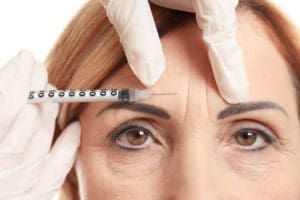 Glabella lines, often referred to as the dreaded “11s,” are the short parallel vertical lines found between the eyebrows and extending up the central forehead for a centimeter or so. They are often the first lines to appear on the forehead, even as early as one’s mid- 20s.
Glabella lines, often referred to as the dreaded “11s,” are the short parallel vertical lines found between the eyebrows and extending up the central forehead for a centimeter or so. They are often the first lines to appear on the forehead, even as early as one’s mid- 20s.
Initially glabella lines are intermittent, appearing only when a person frowns. These lines are considered “dynamic” and are evident when someone makes the angry face that furrows the brow. As time goes on and with repeated movement, the glabella lines become deeper and more permanent.
Glabella lines can look quite deep because the skin in this area is comparatively thick. These “11” lines are created by the dynamic action of the underlying muscles of the glabella (the part of the forehead between the eyebrows), the corrugator supercilii (the muscle above the eyebrow), the procerus (the triangular muscle between your eyes) and the depressor supercilii (the muscle near your inner eyebrow located near the eye). Together they pull the central areas of the eyebrows inward and downward, causing those lovely 11’s to form.
Other external factors that can worsen the glabella lines include sunlight (of course because we squint!), smoking, and exposure to pollution. Patients with thyroid disease who have exophthalmos can have deeper central glabella lines. Individuals with eye sensitivity, contact lens wearers, and those with other eye issues may use the glabella area of the forehead more frequently and consequently have more lines.
We know too that mood can worsen glabella lines: A truly angry person or someone who is constantly frowning can have deeper glabella lines. In fact we have become so habituated to “reading” glabella lines this way that even if the individual is not angry or unhappy, the presence of deep“11” lines can give false signals that this person is always in a bad mood! No wonder many people wear bangs to camouflage their wrinkles on the forehead and glabella. Making that “mad face” can also contribute to headaches and a feeling of central forehead heaviness. Aesthetically, glabella lines can make an upper face look heavy and tired: the muscles can bunch up instead of looking open and relaxed. An open appearance is more attractive to the eye.
The treatment of the “11” lines is aimed at softening and reducing them. Botox® (botulinum toxin A) is a neurotoxin that temporarily paralyzes muscle activity in the area that is treated. This toxin is produced by the microbe clostridium botulinum and is purified, which makes it safe to be used in small doses. Botulinum toxin A stops the muscles of the glabella from contracting and forming furrows. Injection of Botox into the glabella muscle paralyzes the downward and inward muscle action which produces the angry-looking lines.
The Botox injection takes about 5 to 8 days for the effect to kick in; it peaks within about 10 days and continues to render the muscle inactive for 3 to 6 months. Eventually, the treatment wears off and the muscle begins to move again, at which point the treatment can be repeated. There are other neurotoxins available-be sure to check with your provider to see which one is best for you.
Neurotoxins like Botox are the best treatment to help treat and prevent lines and wrinkles of the forehead and around the eyes. They can help soften the lines on the forehead if they are not too deep to start with. Eventually with continued treatment those lines can virtually disappear.
Injections of neurotoxins are given in 2-5 small injections into the particular muscle that is being treated. The pattern is determined when a dermatologic practitioner examines the individual’s musculature. Care is taken to avoid the frozen “Spock” look. The goal is to avoid changing the shape of the eyebrow and to try to maintain the eyebrow arch. A successful treatment is when you cannot move your glabella lines—in other words, when you try to make a mad face but have difficulty doing so!
From time to time when you treat the glabella, patients start to notice other lines on their face including the forehead, eye corners and lower face. For this reason I often recommend treating the forehead, eye corners and glabella together, as an aesthetic whole.
If the glabella lines are kept relaxed over a period of time with regular injections, those deep vertical lines will become less noticeable, and fewer new ones will form. Don’t forget, treatment is aimed at softening or reducing the lines—not at giving a frozen look. It is always best to begin with a smaller dose and increasing the dose progressively if necessary.
